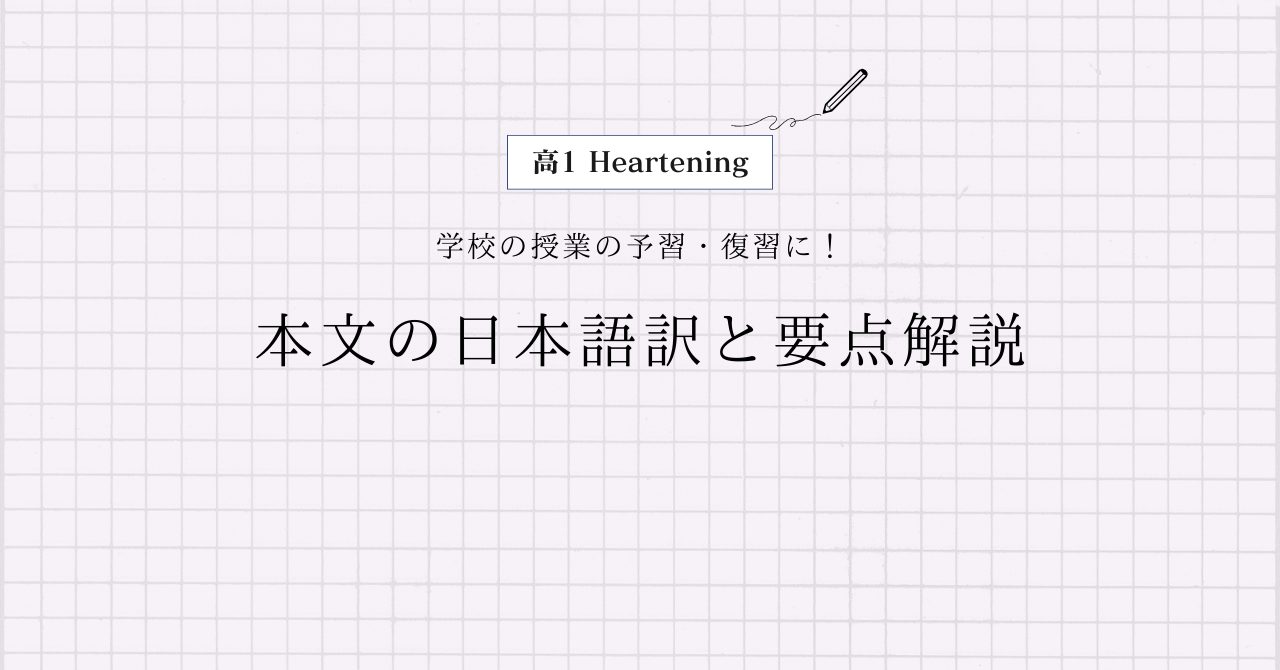桐原書店 高1Heartening Lesson6 Section3の本文の日本語訳と重要箇所の解説です。
Lesson6-1, 6-2, 6-4の解説はこちらからご覧ください。
>高1Heartening Lesson6 Section1 本文和訳
>高1Heartening Lesson6 Section2 本文和訳
>高1Heartening Lesson6 Section4 本文和訳
- Heartening Lesson6 Section3 本文と日本語訳
- Heartening Lesson6 Section3 重要事項の解説
- Might there be another way to bring dinosaurs back to life?
- Some scientists think so.
- They are interested in creating dinosaurs from their descendants living today.
- Do you think I’m talking about crocodiles or lizards?
- Well, you’re wrong. I mean birds.
- Scientists are now certain that birds evolved from dinosaurs.
- An important piece of evidence was the fossil of a dinosaur discovered in China in 1996.
- This dinosaur was about a meter long and covered in feathers.
- Since then a lot of feathered dinosaurs have been found.
- These discoveries tell us that dinosaurs had a lot in common with birds.
- So as it turns out, not all the dinosaurs became extinct 66 million years ago.
- A few lived on.
- They changed their appearance and became today’s birds.
- Heartening Lesson6 Section3 まとめ
Heartening Lesson6 Section3 本文と日本語訳
Might there be another way to bring dinosaurs back to life?
「恐竜を生き返らせる別の方法はあるのでしょうか?」
Some scientists think so.
「一部の科学者はあると思っています。」
They are interested in creating dinosaurs from their descendants living today.
「彼らは今日生きている恐竜の子孫から恐竜を誕生させることに関心があります。」
Do you think I’m talking about crocodiles or lizards?
「私がワニやトカゲについて話していると思っていますか?」
Well, you’re wrong. I mean birds.
「間違いです。私は鳥のことを言っています。」
Scientists are now certain that birds evolved from dinosaurs.
「科学者は今、鳥が恐竜から進化したということを確信しています。」
An important piece of evidence was the fossil of a dinosaur discovered in China in 1996.
「1つの重要な証拠は1996年に中国で発見されたある恐竜の化石でした。」
This dinosaur was about a meter long and covered in feathers.
「この恐竜は全長が約1メートルで、羽毛で覆われていました。」
Since then a lot of feathered dinosaurs have been found.
「それ以来、たくさんの羽が生えた恐竜が見つけられています。」
These discoveries tell us that dinosaurs had a lot in common with birds.
「これらの発見は私たちに、恐竜は鳥と共通点が多いことを教えてくれます。」
So as it turns out, not all the dinosaurs became extinct 66 million years ago.
「つまり結局のところ、すべての恐竜が6600万年前に絶滅したわけではなかったのです。」
A few lived on.
「一部は生きていました。」
They changed their appearance and became today’s birds.
「彼らは見た目を変えて、今日の鳥になったのです。」

Heartening Lesson6 Section3 重要事項の解説
Might there be another way to bring dinosaurs back to life?
ここでは「there構文」が使われていますね。
“might”は助動詞“may”の過去形ですが、ここでは現在形の文の中で使われています。「~かもしれない」といった推量の意味で、“may”よりも確信度が低くなります。
“another”は「別の、他の」という形容詞、“way”は「方法、道」という名詞です。
“bring ~ back to life”で「~を生き返らせる」という意味で、ここでは「不定詞の形容詞的用法」として“another way”を修飾していますね。
“dinosaur”は「恐竜」という名詞です。
Some scientists think so.
“some”は「いくつかの、一部の」といった形容詞で、“scientist“は「科学者」という名詞です。
“think so”は「そう思う」という意味で、ここでは直前の文の内容である「恐竜を生き返らせる他の方法があると思う」ということですね。
They are interested in creating dinosaurs from their descendants living today.
“They”は“Some scientists”を指しています。
“be interested in~”は「~に関心がある、興味がある」という重要表現で、“create”は「を創る」という動詞です。今回は「誕生させる」と訳しました。
また、前置詞“in”の後ろなので“creating”と「動名詞」になっていますね。
“their”は“dinosaurs”を指していて、“descendant”は「子孫」という名詞です。
“living”は「現在分詞」として、直前の“their descendants”を修飾していますよ。
Do you think I’m talking about crocodiles or lizards?
“think”の後ろには「接続詞that」が省略されていますね。
“crocodile”は「ワニ」、“lizard”は「トカゲ」という名詞です。
Well, you’re wrong. I mean birds.
“well”は会話文の文頭に置くと「ええと」といった意味の間投詞になります。
“wrong”は「間違った」という形容詞ですね。
“mean”は「を意味する、~のことを言う・指す」といった動詞になります。
Scientists are now certain that birds evolved from dinosaurs.
“be certain that~”は「~ということを確信している」という重要表現です。“that”は省略可能です。
“evolve”は「進化する」という動詞になります。
An important piece of evidence was the fossil of a dinosaur discovered in China in 1996.
“a piece of~”は「~のかけら、1個の~」といった意味で、“evidence”は「証拠」という不可算名詞です。だから数えるときは今回のように“a piece of~”が必要になります。
“fossil”は「化石」という名詞で、“discover”は「を発見する」という動詞です。
“of”は前置詞で,”A of B”の形で「BのA」というように後ろから前に訳します。
また、“discovered”は「過去分詞」として、直前の“a dinosaur”を修飾していますよ。
This dinosaur was about a meter long and covered in feathers.
“about”は「約、およそ」という副詞で、“meter long”はここでは「全長」ですね。
“cover in~”は「~を覆う」という意味で、ここでは「受動態」になっています。
“feather”は「羽毛、羽」という名詞になります。
Since then a lot of feathered dinosaurs have been found.
“since then”は「それ以来」という表現です。
“feathered”は「羽が生えた」という形容詞で、“found”は“find(を見つける)”の過去分詞形ですね。
ここでは「現在完了の継続用法」と「受動態」がセットになっていますね。
These discoveries tell us that dinosaurs had a lot in common with birds.
“these”は“this”の複数形で,「これらは(の)」といった意味になります。“discovery”は「発見」という名詞ですね。
“tell 人 もの”で「人にものを伝える、教える、言う」ですが,今回のように「もの」の部分に「that 文」を置くこともできます。“that”は省略可能です。
“have a lot in common with~”で「~と多くの共通点がある」という意味になります。
So as it turns out, not all the dinosaurs became extinct 66 million years ago.
“so”は「つまり、だから」といった副詞で、“as it turns out”は「結局のところ」といった表現になります。
“not all~”は「部分否定」で、「すべての~が…というわけではない」という意味です。
“became”は“become(になる)”の過去形で、“become extinct”で「絶滅する」という意味になります。
“million”は「100万(の)」ですね。
A few lived on.
“a few”は「少しの」という意味で,後ろには可算名詞(数えられる名詞)が来ます。ここでは“dinosaurs”が省略されていますね。
“live on”は「生き続ける」という意味になります。
They changed their appearance and became today’s birds.
“They”と“their”は“A few (dinosaurs)”を指しています。
“change”は「を変える」という動詞、“appearance”は「見た目、外見、出現」という名詞ですね。
名詞に‘sを付けると「~の」という所有を表します。
直前の名詞が複数形のときは” teachers‘ “のようにアポストロフィーだけを最後に付けます。
Heartening Lesson6 Section3 まとめ
以上がHeartening Lesson6 Section3の日本語訳となります。
>高1Heartening Lesson6 Section1 本文和訳
>高1Heartening Lesson6 Section2 本文和訳
>高1Heartening Lesson6 Section4 本文和訳
何か分からない点や他に解説してほしい点があれば,お気軽にコメントしてください!



コメント